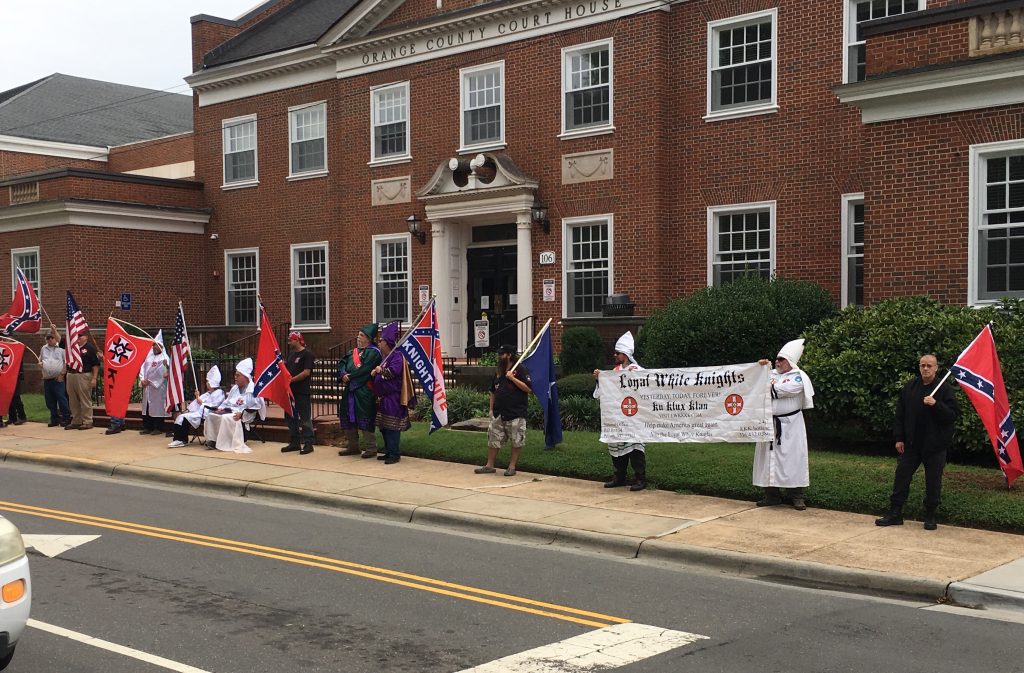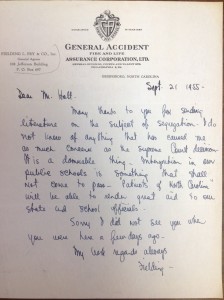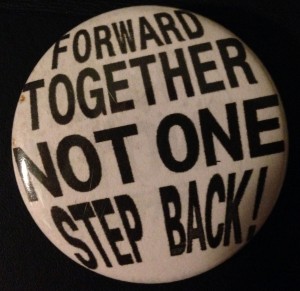When the Klan comes to town
Posted by David On August 30, 2019
Adopted from a late-night Facebook post from Aug. 24, 2019

Representatives of the Pelham Ku Klux Klan in front of the Orange County Courthouse in HIllsborough, NC
As was widely reported, a group of about 15 members of the so-called “Loyal White Knights of the Ku Klux Klan” descended on Hillsborough on the late afternoon of Saturday, August 24. Uninvited and unannounced, they drove from Pelham, NC, an unincorporated corner of northwestern Caswell County (not far from Danville, VA). Pelham is named for for Confederate Col. John Pelham, an artillery officer who fought in the Army of Northern Virginia. So that there would be no confusion as to their political affiliation, this branch of the Klan proclaims on their banner that they want to “Help make America great again.”
I saw them while on my way to Weaver Street Market and did a a double take. I first thought that it was just those same old Confederate flag-wavers at it again. We have had a regular assembly of about 4 battle flaggers over the last year. Those particular flag bearers proclaim on Orange County Local (a Facebook group moderated and dominated by local right wing activists of various stripes) that they gather in Hillsborough to pay respects to their dead Confederate ancestors and that the battle flag of the Army of Northern Virginia is by no means a racist symbol. They’ve been in a tizzy lately following a tongue-in-cheek sidewalk sign by a local chocolatier who offered free chocolate for anyone who burned a Confederate flag. Needless to say, he didn’t really mean it, but the backlash from the flag sympathizers was loud and angry.
But when I saw the pointed hats and assorted other odd uniforms and banners, it became clear that this was different. A drive by (blaring the ska-influenced Russian rock band Leningrad, as one does) revealed that this was a bona fide Klan.
I confess that I didn’t know what to do. It was pretty clear that the assembly had just started, as there was no counter protest, but already heavy police presence. I texted Jennifer Weaver, ran my errand (in a confused, angry rush), and walked over to see what was going on. Already, many anti-racists Hillsboroughisians had gathered to make it known that the Klan is not welcome in our town.
There was no time to agree on tactics, some wanting to directly confront the pointy-hatted racists, stand in front of them, and make them feel uncomfortable. Others thought it best to keep some distance and make immediately obvious that the Klan’s numbers were small.
My first inclination was to track down our “local” battle flaggers, the ones who bristle at any association with the Klan or their flag as a enduring symbol of white supremacy, and ask them to come get their people. My second was more basic: yell “go home,” or something else as simple and unwelcoming.
But I couldn’t stay. A local anti-racist leader wanted her kids to be driven away from the scene (while she remained), my wife wanted to come down, and meanwhile, our son was in the midst of a birthday party sleepover. So I drove our friend’s kids to our house and missed the rest of the Pelham Klan’s presence in our town, and their departure amidst singing of “Hit the Road Jack” from the impromptu anti-Klan crowd.
My Neal family (though I do not know them) came from Caswell County. My Lybrook ancestor—great great grandfather Andrew M. Lybrook—fought for the Confederacy, under that blasted flag, in the Army of Northern Virginia. He was from the same part of Virginia as Pelham’s commander, J.E.B. Stuart; Andrew Lybrook’s town was re-named in “Jeb” Stuart’s honor. Even if my family’s history wasn’t tied up directly in this mess, this past would nevertheless exert gravitational pull on my present.
These Confederate remnants are all around us, the results of ideological work by the Daughters of the Confederacy and Redeemer politicians in the late nineteenth and early twentieth century to consecrate the rise of white supremacy and Black disenfranchisement. To glorify the “Lost Cause” and look away from the possibilities of a multiracial democracy that flared in Reconstruction and again in the Populist-Republican Fusion movement in the 1890s.
So it shouldn’t be surprising that some people from Pelham, a place named for a Confederate officer, should believe the lies of white supremacy, passed along from generation to generation. It shouldn’t be surprising that overt white supremacists are still out there, organizing, rallying behind their *president, waving the military flag of the Confederate army, and showing their faces. Charlottesville showed us that there are young white men who are rallying under the lie. Who feel aggrieved. Who are ready to push this county further into fascism.
A quick look at the reflections from Orange County Local are revealing. Most of the battle-flagger apologists say they want nothing to do with the Klan, and reiterate that the Confederate battle flag has nothing to do with racism or bigotry. Others continue to blame Matthew’s Chocolates for the Klan coming to town. Many say that they want the Klan out, but also want antifa out, making a false equivalency between those who proclaim white supremacy and those who would confront that inherently violent and undemocratic ideology.
I come from a family that, at least in my grandparents’ generation, venerated the Confederacy. They believed the lie. They gravitated from stalwart Democrats to loyal Jesse Helms Republicans. That part of our political landscape seems so unremarkable to me, because it is so familiar. But it is a sign of failure. So much of the political right, at least here in the south, is a remnant of this old allegiance to a twisted story of southern white pride, a belief that low taxes equate to freedom (for those with means), whereas government services, once the civil rights movement forced their provision on an equal basis without regard to race (at least in theory), were seen as illegitimate.
Rejecting the lie means more than telling the Klan to go home. It has to mean not allowing racial disparities in educational outcomes, school discipline, or any other facet of our public lives.
A note on sources for
“Hiding in Plain Sight”
Posted by David On July 14, 2015
I am humbled by the warm reception that the Scalawag article has received. Thank you for the many kind words. For those who have read it and would like to learn more, I offer a partial list of sources. For either space or aesthetic reasons, the footnotes in the final draft were omitted for publication.
I first learned about the existence of the Patriots of North Carolina from an exceptional book that tells the story of the North Carolina Fund, a pioneering anti-poverty initiative in the 1960s. Robert R. Korstad & James L. Leloudis, To Right These Wrongs: The North Carolina Fund and the Battle to End Poverty and Inequality in 1960s America, UNC Press (2010).
The quote from the President of the Patriots of NC came from: W. C. George, The Biology of the Race Problem, A Report of the Commission of the Governor of Alabama (1962). See also George Lewis, “Scientific Certainty”: Wesley Critz George, Racial Science and Organized White Resistance in North Carolina, 1954-1962,” Journal of American Studies, 38:2 (2004).
The term “Progressive Plutocracy” was coined by V. O. Key, Jr., Southern Politics in State and Nation A.A. Knopf (1949); Fellow Scalawag contributor Prof. William Chafe modified this formulation, dubbing North Carolina’s politics a “progressive mystique” in Civilities and Civil Rights: Greensboro, North Carolina, and the Black Struggle for Freedom, Oxford University Press (1981). Prof. Chafe’s book was an invaluable source for understanding the Civil Rights movement in Greensboro and the context in which the Patriots were founded.
Information about the Pearsall Plan and North Carolina’s success at holding off integration came largely from the following sources and other documents in the W. C. George Papers at the Southern Historical Collection:
• The Pearsall Plan to Save Our Schools, educational brochure prepare by the Advisory Committee on Education [thePearsall Committee] (1956)
• William W. Taylor, Jr., My First Ninety Years (2002) [unpublished memoir, provided by his son, William W. Taylor, III; William Taylor, Jr. staffed the Pearsall Committee with his future law partner, Tom Ellis]
• I was reminded of Gov. Hodges’s attempt to enlist African American support for what he called “voluntary segregation,” urging Black parents not to attempt and integrate White schools by Anders Walker, The Ghost of Jim Crow: How Southern Moderates Used Brown v. Board of Education to Stall Civil Rights, Oxford U Press (2009).
• Davison Douglas, The Rhetoric of Moderation: Desegregating the South During the Decade After Brown, 89 Nw. U. L. Rev. 92 (1994). In 1964, less than one percent of North Carolina’s African American pupils attended school with Whites.
• John Drescher, Triumph of Good Will: how Terry Sanford Beat a Champion of Segregation and Reshaped the South, University press of Mississippi (2000).
These books (and article) provide a great overview of how massive resistance to the Brown decision developed across the South:
• Neil R. McMillen, The Citizens’ Council: Organized Resistance to the Second Reconstruction, U of Illinois Press (1971)
• Numan V. Bartley, The Rise of Massive Resistance: Race and Politics in the South During the 1950’s, LSU Press (1969)
• Francis M. Wilhoit, The Politics of Massive Resistance, George Braziller (1973)
• Sarah H. Brown, The Role of Elite Leadership in the Southern Defense of Segregation, 1954-1964, Journal of Southern History, Vol. 77, No. 4 (Nov. 2011)
Information about efforts to enforce desegregation orders, the state of my hometown schools, and how racial discrimination is at the root of housing patterns that are still with us today was found here:
• Nikole Hannah-Jones, Lack of Order: The Erosion of a Once-Great Force for Integration, ProPublica (May 2014)
• John Hinton, Winston-Salem Practiced Jim Crow when Winston and Salem were Consolidated,” Winston-Salem Journal (June 30, 2013). In discussing residential segregation, it is important to note that it cannot be ascribed to unfettered choice. In my hometown of Winston-Salem, segregation was written into the zoning code in 1912 and restrictive covenants, prohibiting the sale of real estate to people of color, were commonplace. For decades thereafter, federal housing policy reinforced such segregation, with FHA loans going overwhelmingly to White homeowners in neighborhoods that were inaccessible to African Americans. Though these policies have not been in force since the late 1960s, racially segregated neighborhoods, with vast gulfs between home values, remain.
• For data about Winston-Salem/Forsyth County Schools, I turned to Jennifer B. Ayscue et al, Segregation Again: North Carolina’s Transition from Leading Desegregation Then to Accepting Segregation Now, Civil Rights Project at UCLA (May 14, 2014) (Winston-Salem Metro Summary [pdf])
• Ta-Nehisi Coates’s writing has been critical in unearthing the larger story of how federal and state policy shaped the structural disadvantage in housing policy for African Americans while simultaneously creating a path to middle class wealth accumulation for Whites. See Coates, The Case for Reparations, the Atlantic (June 2014)
• I found extremely helpful insights into the nature of locked-in advantages for Whites that lingers today from the Jim Crow era from Daria Roithmayr, Reproducing Racism, NYU Press (2014) (h/t Jed Purdy)
For background into Chief Justice Roberts’ ideological and policy positions in the Reagan White House, see Jeffrey Toobin, No More Mr. Nice Guy: The Supreme Court’s Stealth Hard-Liner, New Yorker (May 25, 2009) and Testimony of Wade Henderson, Executive Director of the Leadership Conference on Civil Rights, before the Senate Judiciary Committee (Sept. 15, 2005)
There is a brisk summary of how Tom Ellis and Jesse Helms’s political team engineered Ronald Reagan’s improbable victory over the incumbent President Ford in the North Carolina’s 1976 Republican Primary in Rick Perlstein’s Invisible Bridge, Simon & Schuster (2014). Jesse Helms built his brand of dog-whistle conservative politics as a commentator on WRAL-TV, a station owned by A. J. Fletcher, law partner in the 1950s to pro-segregation gubernatorial candidate and frequent Patriots of NC speaker I. Beverly Lake, Sr.
For more on the idea that Jim Crow segregation played an instrumental role in the southern labor system, see Jason Morgan Ward, Defending White Democracy: The Making of a Segregationist Movement and the Remaking of Racial Politics, 1936-1965, UNC Press (2014) (noting that southern industrialists began to fight New Deal policies in order to maintain the “competitive advantage that cheap black labor provided” and because they believed that a “segregated, low-wage labor system provided the South a path to modernization and prosperity.”). See also David Cunningham, Klansville, U.S.A.: The Rise and Fall of the Civil Rights-Era Ku Klux Klan, Oxford University Press (2012).
The Southern States Industrial Council was a powerful coalition of conservative businessmen that fought hard to maintain segregation and the low-wage southern labor system with ties to the Dixiecrats and the Federation for Constitutional Government. North Carolina’s own David Clark, brother of Patriots-founder John Clark, published the Southern Textile Bulletin. David Clark used the specter of Blacks and Whites working together in the mills to fire up working class opposition to liberal politicians, most notably Frank Porter Graham in the infamous primary run-off with Willis Smith in 1950.
Examples of the dominant myth that Black involvement in civic and political life in Reconstruction and during the Fusion era lead to corruption are not hard to find: “[the] brief rule [of ‘Carpet-baggers and their Negro allies’] was characterized by inefficiency, extravagance, violence, and unblushing corruption.” Hugh Lefler and Albert Newsome, North Carolina, UNC Press (1953); see also R.D.W. Conner and Clarence Poe, The Life and Speeches of Charles Brantley Aycock, Doubleday, Page & Company (1912). Gov. Aycock left no doubt about the central role of White Supremacy and ending what he deemed the corrupt “Negro rule” during the Fusion era in working to reassert the dominance of the Whites-only Democratic Party.

The first letter that I found from Fielding in the archives (Erwin A. Holt Papers, Southern Historical Collection)
Monday Movement
Posted by David On May 27, 2015
The time for half-hearted measures has ended
The hour for parlay is past
Raise the barricades
Light the fires
Hold the lines
The call: we do what?
We fight, we fight, we fight!
What do we do, we too few?
What is to be done, dum ditty dum?
The base is rotting,
Foundation falling.
Elephants stomp upon the roots,
Devouring the fresh green shoots.
What will remain of our heartwood
Before the big top comes down
On the circus that has taken over town?
There’s no ground left to give
Stand or be driven into the rising sea
Breathe a prayer for profit corrupts the air
The hard rain is falling,
Complacency calling
we fight we fight we fight
Do I lace-up the gloves
Step into the ring
Face off when the bell rings?
we might we might we might
Can I show up with half a heart no more?
Offer no quarter no more
Fly solo no more
Cop nolo contedere pleas no more
We are in the last round
To negotiate is to capitulate
And to capitulate brings doom.
The center has no gravity to hold
So fight for love,
Fight for the heartwood,
Fight for the light
The final bell has not rung.
May 2013
From the fire
Posted by David On May 26, 2015
Captured by my 6 year-old Iphone 3GS
Beginnings
Posted by David On April 29, 2015
As time allows, I will use this space to carve out ideas, primarily with rough-edged writing, mostly prose. I hope to share some more finished, smoother-sanded words as well. And the occasional picture. More to follow…


